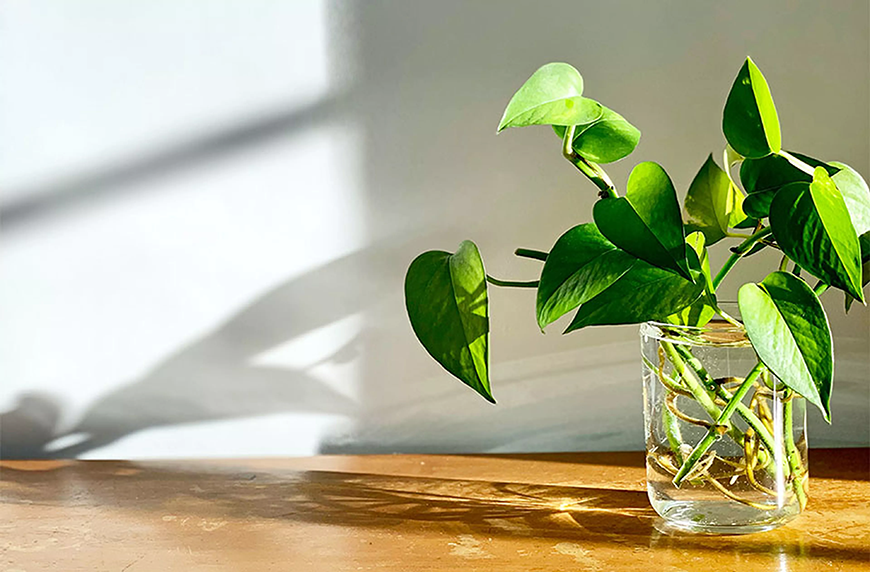How to Find Free Plants: 6 Simple Ways to Add to Your Collection
Free plants are easy to find. Here are some no-cost ways to add to your collection, from attending plant swaps to planting food scraps.

Published
As someone who visits greenhouses and plant shops on a regular basis, I'm always looking for ways to feed my obsession more sustainably... and affordably.
The pandemic has resulted in millions of new plant parents. Since it was hard to get outside for a couple of years, we brought the greenery indoors. Unfortunately, despite all the benefits of owning houseplants (hello, mood boost!), there are some downsides, too. Namely, the industry's overwhelming use of peat—the material most houseplants are grown in.
While supporting local greenhouses that have sustainable practices in place is great for your community and the planet, sometimes being eco-friendly means limiting buying new and utilizing what you already have. Or, what other people already have and are looking to get rid of.
If you're looking for free plants, here are some simple ways to start adding to your collection. And who knows—maybe you'll even make some new friends along the way.
6 Easy Ways to Find Free Plants
1. Download a Free Plant App

The Blossm app is essentially a social media platform for plant lovers; you're able to connect with people in your community and swap plants or cuttings.
Here's how it works: After logging into the app, you can browse plants in your local area to buy, swap, or get for free. On the seller side, you can also post anything you'd like to sell, swap, or donate. Once you spot a plant or cutting you love, you can (safely) meet up in a public place for an exchange.
What's also cool about this app is that it can help plant lovers reduce waste from gardening goods. Aside from being able to expand your indoor garden, you can find free pots, planters, supplies, and accessories that help you take care of your new plant babies.
Not sure what your free plant is? Use a plant identification app so you know how to care for it.
2. Browse Online Marketplaces

You might already use Facebook Marketplace and Craigslist for finding furniture and other household items. But guess what? It's becoming a hotspot for finding free plants, too.
After logging into Facebook, select "Marketplace" and search for "plant." Then change your setting from "shipped and local" to "local" and update your radius depending on how far you're willing to travel. After tapping "see items," you'll be left with free plants or low-cost plants in your area.
If you're hoping to get your hands on a rare plant—like something variegated—you might get lucky on these platforms. You never know what you'll come across as you're scrolling.

Terra Stone Plant Coasters Set
Get 15% off your order by using the code ECONEWS at checkout!
3. Attend a Plant Swap

Plant swaps are the new clothing swaps—an opportunity for like-minded individuals to get together and share their love of monsteras, pothos, and beyond. There's only one requirement to attend: You must bring a plant or clipping to swap with other attendees, so everyone leaves with a fun new addition to their indoor garden.
Since plant swaps are still new, finding one isn't always easy. Plant expert Khoa Hoang recommends following local plant shops on Instagram, which may be hosting a swap. Also, follow plant influencers in your area. They're typically in-the-know about upcoming events.
4. Propagate Existing Plants

You've taken such great care of your plants over the years. Now, it's time for them to return the favor. Learning how to propagate a plant is super easy: You simply secure a "cutting" by cutting off a healthy piece of an existing plant and rooting it. Before you know it, it has regenerated into a new plant that's ready to pot and enjoy for years to come.
If you have friends with plants, they'll likely let you snag a cutting from them for free. If you see one you would love to add to your collection, all you need to do is ask.
5. Adopt from a Local Greenhouse or Plant Shop

Sometimes, local greenhouses and plant shops will allow plants that are in need of a little extra TLC to be adopted free of cost. If you have the time (and patience!) to care for a plant that may not be #thriving, it's a great opportunity to add to your collection without spending a cent.
Here's the catch: If the plant is dying, it may be due to a problem that could spread to your other healthy plants, like a pest issue. Do a thorough investigation before bringing it into your space by using this checklist. It may need to be quarantined and treated before being added to your collection.
6. Grow Plants from Food Scraps

That's right! You can turn your food scraps into free plants. It's easy, too. We have three guides to get you started, all of which utilize scraps you probably have on a weekly basis.
You can plant a pineapple top, which gives you a fun, spiky houseplant. You can also learn how to grow a sweet potato vine plant that trails around your home or get the scoop on how to grow an avocado plant from a pit. Talk about turning trash into treasure.

Try Tracy Anderson's Vegan Spaghetti Squash with Creamy Mushrooms Recipe
Tracy Anderson's vegan spaghetti squash with creamy mushrooms recipe is just as good for you as it is for the planet. Here's how to make it.

Thousands of Recently-Rescued Beagles Need Homes—Here’s How You Can Help
Thousands of beagles rescued from Envigo, a breeding and research facility in Virginia, need homes. Here's what you can do to help.

Sustainable Picks From the Nordstrom Anniversary Sale 2022
The Nordstrom Anniversary Sale 2022 has arrived. Here are the sustainable picks we're shopping—jewelry, accessories, and more.

